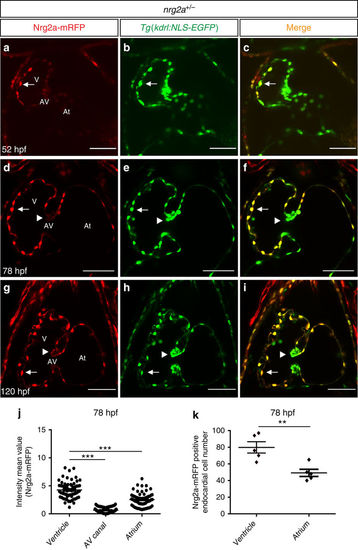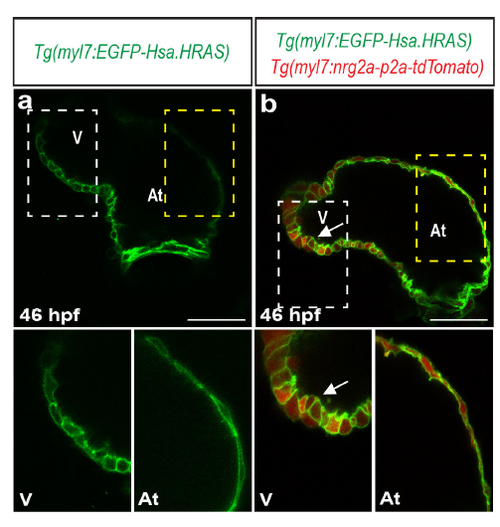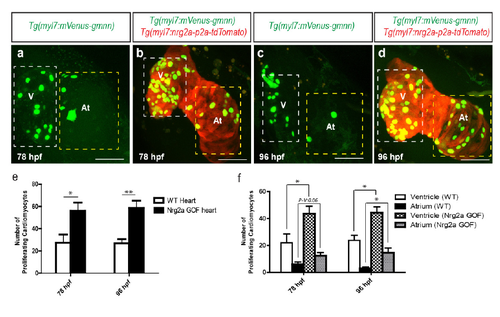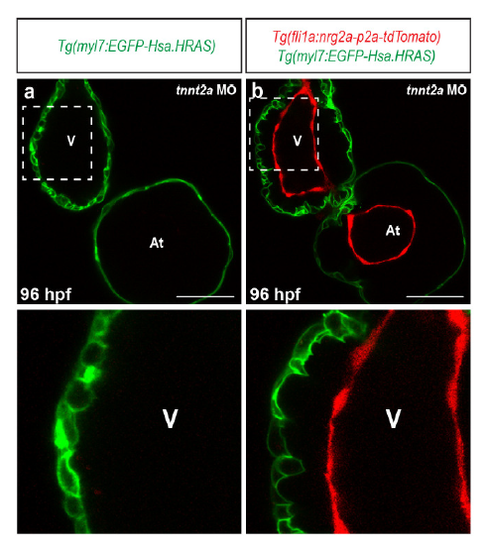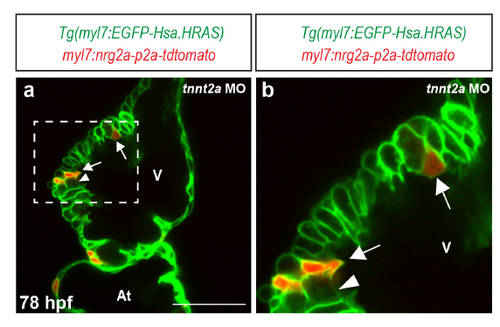- Title
-
Regulation of cardiomyocyte behavior in zebrafish trabeculation by Neuregulin 2a signaling
- Authors
- Rasouli, S.J., Stainier, D.Y.R.
- Source
- Full text @ Nat. Commun.
|
Nrg2a is required for cardiac trabeculation in zebrafish. (a,b) Zebrafish larvae from nrg2a+/− incrosses were imaged at 120 hpf; lateral view, anterior to the left; scale bars, 0.5 mm. nrg2a−/− larvae can be recognized by their defective jaws (asterisk in b). (c–k) nrg2a mutants lack cardiac trabeculae. Confocal images (mid-sagittal sections) of larval hearts from Tg(myl7:LIFEACT-GFP);nrg2a+/− incrosses at 75 (c–e), 120 (f–h) and 168 hpf (i–k); ventricular outer curvature (dashed boxes) magnified in upper right corners; arrows and asterisks indicate trabeculated and non-trabeculated walls, respectively; scale bars, 50 μm. EXPRESSION / LABELING:
PHENOTYPE:
|
|
Nrg2a-mRFP expression during embryonic and larval cardiac development. (a–i) Two-dimensional (2D) confocal images (mid-sagittal sections) of zebrafish hearts from Tg(kdrl:NLS-EGFP);nrg2a+/− outcrosses at 52 (a–c), 78 (d–f) and 120 hpf (g–i) showing that Nrg2a-mRFP expression is clearly visible in the ventricular endocardium by 52 hpf, mainly in the outer curvature (a–c), and that it becomes stronger in both ventricular and atrial chambers at 78 and 120 hpf (d–i); however, it is weak in the atrioventricular canal; arrowheads point to the superior valve leaflet (a–i); AV, atrioventricular canal, At, atrium; V, ventricle; scale bars, 50 μm. (j) Cell-based mRFP intensity, measured with the ZEN Imaging Software and plotted as a graph, showing that Nrg2a-mRFP is more highly expressed in the ventricle compared to the AV canal and atrium; dots in this graph represent individual Nrg2a-mRFP expressing endocardial cells. (k) Nrg2a-mRFP positive endocardial cells counted in each chamber at 78 hpf, showing that there are more Nrg2a-mRFP positive endocardial cells in the ventricle than in the atrium at 78 hpf; dots in this graph represent individual hearts; N=5 hearts; values represent means±s.e.m.; **P≤0.01, ***P≤0.001 by Student’s t-test. |
|
Reduction of cardiac jelly thickness in developing zebrafish. (a–h) Mid-sagittal confocal sections of late embryonic and early larval zebrafish hearts. Animals from Tg(kdrl:Hsa.HRAS-mCherry);Tg(myl7:EGFP-Hsa.HRAS) incrosses were synchronized at the tail bud stage (10 hpf) and imaged at 48 (a), 54 (b), 60 (c), 72 (d), 80 (e), 96 (f), 120 (g) and 144 hpf (h); endocardial and myocardial membranes are labelled in red and green, respectively; AV, atrioventricular canal, At, atrium; V, ventricle; scale bars, 50 μm. Higher magnification images of outer curvature area of ventricular (white dashed boxes) and atrial (yellow dashed boxes) walls are shown beneath each time point, respectively. The cardiac jelly is initially thicker in the atrium than in the ventricle at 48 hpf (a). It is greatly reduced in the ventricle by 72 hpf, (b–d) and almost fully gone by 96 hpf, while it is still detectable at 120 hpf in the atrium (e–h); arrowheads point to trabecular cardiomyocytes; arrows and asterisks indicate the presence and absence of cardiac jelly, respectively. |
|
Myocardial nrg2a overexpression induces cardiomyocyte multilayering in nrg2a mutants. (a) Cartoon of myocardial specific nrg2a construct. (b) Schematic representation of Nrg2a protein tagged by tdTomato. Due to the presence of the P2A peptide, cleavage occurs right after protein translation to separate the Nrg2a from the tdTomato fluorescent protein. (c–e) 2D confocal images (mid-sagittal sections) of Tg(myl7:LIFEACT-GFP);nrg2a−/− hearts injected with myocardial specific nrg2a construct (myl7:nrg2a-p2a-tdTomato) at the one-cell stage. Mosaic overexpression of nrg2a in nrg2a−/− cardiomyocytes led to the formation of a multilayered myocardial wall which is outlined by a white dashed box and magnified (c–e); arrows point to nrg2a overexpressing cardiomyocytes. (f–i) Confocal images (mid-sagittal sections) of 120 hpf Tg(myl7:EGFP-Hsa.HRAS) hearts from erbb2+/− incrosses injected with the myl7:nrg2a-p2a-tdTomato construct (h–i). Magnified images of dashed boxes are shown below c–i; arrows point to nrg2a overexpressing cardiomyocytes, arrowheads point to trabeculae and asterisks indicate lack of trabeculae. At, atrium; V, ventricle; scale bars, 50 μm. |
|
Myocardial specific nrg2a overexpression can lead atrial cardiomyocytes to form a multilayered wall. (a) Illustration of cardiomyocyte specific nrg2a overexpression in zebrafish. (b–i) 2D confocal images (mid-sagittal views) of Tg(myl7:EGFP-Hsa.HRAS) and Tg(myl7:EGFP-Hsa.HRAS);Tg(myl7:nrg2a-p2a-tdTomato) hearts at 50 (b,c), 78 (d,e), 120 (f,g) and 144 hpf (h,i); magnified images of dashed boxes are shown below each time point; arrows point to multilayered walls; At, atrium; V, ventricle; scale bars, 50 μm. |
|
Contractility/blood flow is required for endocardial expression of nrg2a but not the ability of cardiomyocytes to respond to nrg2a. (a–i) Maximum intensity z-projections (25–30 z-stacks, mid-sagittal sections) of Tg(kdrl:NLS-EGFP);nrg2a+/− hearts from non-treated (a–c), tnnt2a MO injected (d–f) and BDM treated (g–i) 78 hpf larvae; scale bars, 50 μm. (j–l) Graphs showing cell-based Nrg2a-mRFP intensity in outer curvature (yellow box) and inner curvature (green box) of hearts from non-treated (j), tnnt2a MO (k) and BDM treated (l) 78 hpf larvae; dots represent individual Nrg2a-mRFP expressing endocardial cells. Values represent means±s.e.m.; **P≤0.01, ***P≤0.001, NS (not significant), by Student’s t-test. (m,n) 2D confocal images (mid-sagittal sections) of 78 hpf Tg(myl7:EGFP-Hsa.HRAS) (m) or Tg(myl7:EGFP-Hsa.HRAS);Tg(myl7:nrg2a-p2a-tdTomato) hearts (n) showing that myocardial overexpression of nrg2a can induce cardiomyocyte multilayering in tnnt2a morphants; asterisks and arrows indicate single-layered and multilayered ventricular walls, respectively. (o–r) Maximum intensity z-projections of TgBAC(cdh2:cdh2-EGFP) hearts from non-injected (o), injected with tnnt2a MO alone (p) or injected with tnnt2a MO and myl7:nrg2a-p2a-tdTomato plasmid (q,r) 96 hpf larvae. (r) 2D confocal image (sagittal section) of heart shown in q. Magnified images of dashed boxes are shown below (o–r); arrowheads and lozenges indicate presence and absence of Cdh2-EGFP proteins on the basal side of cardiomyocytes, respectively; At: atrium; V, ventricle; scale bars, 50 μm. (s) Schematic diagram of modulation of Nrg2a/Erbb2 signaling by cardiac contractility/blood flow. EXPRESSION / LABELING:
PHENOTYPE:
|
|
nrg1bns101/bns101 embryos develop a functional heart and survive to adulthood (a-b) Cartoon of Talen-induced nrg1 mutation with a 14-base-pair deletion in exon 2 (a); this deletion causes a frame shift leading to a premature stop codon in exon 2 resulting in a predicted truncated protein (b). Notably, the predicted truncated Nrg1 protein in nrg1bns101/bns101 animals lacks the Ig-like, EGF-like and TM domains that have all been reported to be essential for mouse cardiac trabeculation 1, 2, 3. If the first ATG downstream of the 14 bp deletion is used to reinitiate translation, a protein consisting of part of the TM domain and the carboxy terminal domain will be made. However, the type IIIa Nrg1 isoform 4 is not predicted to be affected by the bns101 mutation. (c-d) nrg1bns101/bns101 larvae do not exhibit any gross morphological defects as compared to wild-type; lateral views, anterior to the left; scale bars, 0.5 mm. (e-h) Trabeculation appears unaffected in nrg1bns101 mutants. 120 hpf larvae from Tg(myl7:LIFEACT-GFP); nrg1bns101/+ incrosses imaged by spinning disk confocal microscopy; 2D views (mid-sagittal sections) (e and f), and 3D maximum intensity z-projections (g and h); V: ventricle; arrows point to trabecular cardiomyocytes; scale bars, 50 μm. |
|
Cardiac Nrg2a-mRFP expression during embryonic and larval development (a-i) Mid-sagittal confocal images of Tg(kdrl:NLS-EGFP);nrg2a +/- hearts; heat map; low intensity (blue) to high intensity(red) at 52 (a-c), 78 (d-f) and 120 (g-i) hpf; arrows and arrowheads point to endocardial cells in ventricular outer curvature and superior AV valve leaflet, respectively. (j) Graph showing that on average there is a higher percentage of endocardial cells positive for Nrg2a-mRFP in the ventricle than in the atrium at 78 hpf; dots in this graph represent individual hearts; N=5 hearts; values represent means ± SEM; ** P≤ 0.01 by Student’s t-test. (k) In situ hybridization for nrg2a expression in 78 hpf heart. V: ventricle, AV: atrioventricular canal, At: atrium; scale bars, 50 μm. |
|
Spatiotemporal pattern of cardiac Nrg2a-mRFP expression during embryonic and larval development (a-i) 3D views (maximum intensity z-projections) of Tg(kdrl:NLS-EGFP);nrg2a +/- hearts at 52 (a-c), 78 (d-f) and 120 (g-i) hpf; Nrg2a-mRFP expression appears stronger in the ventricle than in the atrium or AV canal; V: ventricle, AV: atrioventricular canal, At: atrium; scale bars, 50 μm. |
|
nrg2a-/- hearts develop functional atrioventricular valves (a-c) Maximum intensity z-projections (25 z-stacks, sagittal sections) of 120 hpf Tg(kdrl:NLSEGFP); nrg2a+/- AV canal showing that Nrg2a-mRFP is weakly expressed in the AV valve leaflets. (d-i) Mid-sagittal confocal images of hearts from Tg(kdrl:NLS-EGFP);nrg2a+/- incrosses at 80 (d-f) and 120 (g-i) hpf; arrows and arrowheads point to superior and inferior valve leaflets, respectively; V: ventricle, AV: atrioventricular canal, At: atrium; scale bars, 50 μm. |
|
Developmental analysis of cardiac jelly thickness in the presence or absence of Nrg/Erbb2 signaling (a-h) Mid-sagittal views of wild-type and nrg2a-/- hearts from Tg(kdrl:Hsa.HRASmCherry); Tg(myl7:LIFEACT-GFP);nrg2a+/- incrosses at 55 (a-b), 60 (c-d), 72 (e-f) and 80 (gh) hpf; the myocardium and endocardium are labeled in green and red, respectively; magnified images of dashed boxes are shown below each time point. The thickness of the cardiac jelly progressively diminishes in wild-type and nrg2a-/- hearts. (i-k) Confocal sagittal sections of 82 hpf Tg(kdrl:Hsa.HRAS-mCherry);Tg(myl7:EGFP-Hsa.HRAS) hearts from wildtype (i), nrg1-/- mutant (j) or Erbb2 inhibitor (PD168363) treated animals showing that cardiac jelly reduction also appears to be an Nrg1/Erbb2 independent process; magnified views of dashed boxes in i-h are shown on the right; arrows and asterisks indicate the presence and absence of cardiac jelly, respectively; V: ventricle, AV: atrioventricular canal, At: atrium; scale bars, 50 μm. |
|
Myocardial nrg2a overexpression causes cardiomegaly in wild-type fish (a-d) A number of injected F0 wild-type fish (6 out of 31) exhibited pericardial edema at juvenile and adult stages as compared to non-injected ones; lateral views of non-injected (a) and injected (c) zebrafish imaged by brightfield microscopy at 75 dpf; red arrowhead in c points to pericardial edema; scale bars, 1mm. 75 dpf extracted hearts from non-injected (b) and injected (d) fish; scale bars, 200 μm. |
|
Overexpression of nrg2a under control of a myocardial specific promoter induces cardiomyocyte bilayering in the ventricle by 46 hpf (a-b) 2D ventral views (mid-sagittal sections) of 46 hpf Tg(myl7:EGFP-Hsa.HRAS) (a) or Tg(myl7:EGFP-Hsa.HRAS);Tg(myl7:nrg2a-p2a-tdTomato) (b) hearts; Magnified images of dashed boxes are shown below a and b; arrows point to bilayered wall; V: ventricle, At: atrium; scale bars, 50 μm. |
|
nrg2a overexpression in cardiomyocytes requires Erbb2 function (a-d) Confocal sagittal sections of Tg(myl7:EGFP-Hsa.HRAS) (a-b) or Tg(myl7:EGFPHsa. HRAS);Tg(myl7:nrg2a-p2a-tdTomato) (c-d) hearts, treated with DMSO (a and c) or the Erbb2 inhibitor PD168363 (b and d) showing that nrg2a overexpression-induced cardiomyocyte multilayering requires Erbb2 function; asterisks and arrows indicate singlelayered and multilayered ventricular walls, respectively; V: ventricle, At: atrium; scale bars, 50 μm. |
|
Myocardial specific nrg2a overexpression leads to an increase in cardiomyocyte proliferation (a-d) 3D views (maximum intensity z-projections) of Tg(myl7:mVenus-gmnn) (a and c) or Tg(myl7:mVenus-gmnn);Tg(myl7:nrg2a-p2a-tdTomato) (b and d) hearts at 78 (a-b) and 96 (c-d) hpf. Proliferating cardiomyocytes are labeled in green; white and yellow dashed boxes outline the ventricular and atrial chambers, respectively; V: ventricle, At: atrium; scale bars, 50 μm. (e-f) Graphs showing the average number of proliferating cardiomyocytes per heart (e) and per ventricular or atrial (f) chamber at 78 and 96 hpf; N=9 hearts; values represent means ± SEM; * P≤ 0.05,** P≤ 0.01 by Student’s t-test. EXPRESSION / LABELING:
PHENOTYPE:
|
|
Endocardial specific overexpression of nrg2a does not induce cardiomyocyte multilayering in tnnt2a morphants (a-b) 2D ventral views (mid-sagittal sections) of 96 hpf Tg(myl7:EGFP-Hsa.HRAS) (a) or Tg(fli1a:nrg2a-p2a-tdTomato);Tg(myl7:EGFP-Hsa.HRAS) (b) hearts from tnnt2a MO (0.5 ng) injected animals; magnified images of dashed boxes are shown below a and b; myocardium and endocardium are labeled in green and red, respectively; V: ventricle, At: atrium; scale bars, 50 μm. |
|
Nrg2a can affect cardiomyocyte behavior via both autocrine and paracrine signals (a-b) 2D ventral views (mid-sagittal sections) of 78 hpf Tg(myl7:EGFP-Hsa.HRAS) hearts from animals injected with tnnt2a MO (0.5 ng) and myl7:nrg2a-p2a-tdTomato DNA (5-10 pg). This low amount of DNA allows one to get single cardiomyocytes to overexpress the nrg2a transgene; arrows and arrowhead point to nrg2a-p2a-tdTomato expressing and nonexpressing cardiomyocytes, respectively; higher magnification of dashed box in a is shown in b; V: ventricle, At: atrium; scale bar, 50 μm. |


